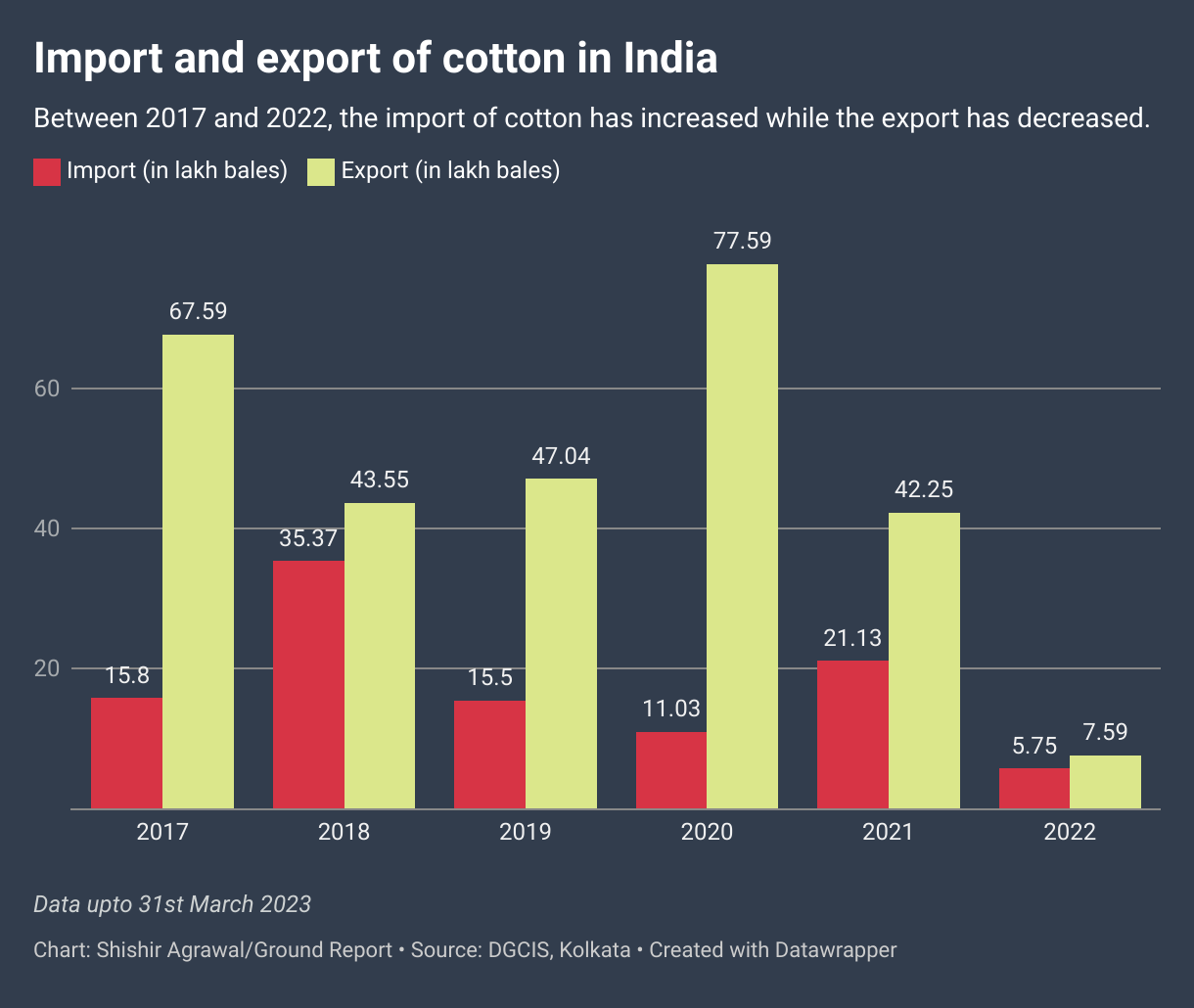Madhya Pradesh, Chief Minister Dr. Mohan Yadav recently said that the state has immense potential in the field of textile and garment industry. He announced,
“The government has rolled out several schemes and benefits favourable for the sector to boom. Like providing electricity and water at minimum rates. GST exemption, tax rebate and other incentives for investors.”
To promote the textile industry, the government has also specially prepared a customized incentive package, which provides financial assistance to the industries according to their investment needs.
PM Mega Integrated Textile Region and Apparel Park (PM MITRA) is also being built in Dhar district to promote textile and garment industry in Madhya Pradesh. In the recently concluded Global Investors Summit (GIS) in Bhopal, the Chief Minister also encouraged investors to invest in the state’s textile industry.
Khargone district, located about 188 km from the same PM MITRA, is known for producing the highest amount of cotton in the state. This cotton production forms the backbone of the local ginning mill industry.
At the ginning mills, cotton boll is processed to separate the fiber (cotton lint) from the seed (cotton seed). The cotton’s moisture content is then controlled, and it is compressed into bales. These bales are later sent to yarn and textile factories for further processing.

In simple terms, the raw material for the textile industry that the Chief Minister aims to promote is sourced from the ginning mills in Khargone.
Sandeep Jaiswal, one of the ginning mill owners in Khargone, is unhappy with the government’s policies. He says that while the government keeps raising the minimum support price (MSP) for cotton, most of the cotton is being bought by the Cotton Corporation of India Limited (CCI), leaving them with less opportunity to buy raw material.
Jaiswal describes this as a ‘double problem’ for cotton ginning traders in Khargone. On one hand, the price of raw material keeps rising, and on the other, it’s harder to find.
“We’ve become tenants in our own house. CCI is buying all the cotton, prices are going up, and if this continues, we’ll have to shut down our business,” he says.
This has led to the closure of cotton ginning mills in the Nimar region. The impact has been widespread, affecting not only the mill owners but also the tribal community members who worked as laborers.
Khargone’s cotton and MSP
Cotton is a major cash crop for both the country and Madhya Pradesh. Madhya Pradesh produces 43% of the country’s cotton and 24% of the world’s cotton. According to the Economic Survey 2024-25, in the financial year 2023-24, 873 thousand metric tonnes of cotton was produced in 630 thousand hectares in the state. However, this is less than the 890 thousand metric tonnes produced in the year 2022-23.
Khargone falls in the Nimar region of Madhya Pradesh. This region is considered important for cotton production because of its rich aluvial soil and warm climate– both suitable for cotton. Khargone is the leading district in terms of cotton production in the entire state.
In 2022-23, 2,52,953 metric tonnes were produced in this district. You can guess how much dependence the farmers of the district have on this crop from the fact that Khargone has a total 405.668 thousand hectares of irrigated area. Out of this, cotton is cultivated in the maximum area of 211.450 thousand hectares.

That is, during the Kharif season, the sale-purchase of this crop is most important for both traders and farmers. For both the classes, this is the biggest part of their annual income.
In such a situation, a section of ginning traders say that either the government should bring a provision for increasing MSP every year and buying cotton through CCI or consider options like giving subsidies to the ginning industry.
Manjeet Chawla, who has been doing cotton ginning business for about 40 years, is also the founder president of Madhyanchal Cotton Ginners and Traders Association. He says that the rate of cotton is low in the international market while it is high in India. Due to this, Indian traders are lagging behind in the international market.
Kailash Agrawal, State Vice President of Federation of Madhya Pradesh Chambers of Commerce and Industry (FMPCCI), explains this,
“India’s textile industry has to make yarn and cloth and sell it in the international market. If the textile industry gets raw material at a higher price, then it will also sell its product at a higher price. While countries like Brazil will be selling goods at a lower price, in such a situation, the number of people buying goods from Indian traders in the international market decreases.”
He complains that the government gives MSP to the farmers for vote bank but does not give any subsidy to the traders. Additionally, CCI buys high-quality cotton at MSP, leaving traders with lower-quality goods.
It is worth noting that between 2017 and 2022, the import of cotton has increased while the export has decreased. In 2017-18, 15.80 lakh bales of cotton were imported, which reached 21.13 lakh bales in 2021-22. Whereas in 2017, 67.9 lakh bales of cotton were exported from India, which increased to 42.25 lakh bales in 2021-22.
At the same time, Chawla says that due to the purchase of cotton by CCI, traders who are not tied up with CCI are not able to get raw material. Due to this, they are not able to work according to their capacity. Sandeep also reiterates this. He says,
“This year, we have been able to buy only 50% of the raw material we had last year. All the goods have gone to CCI.”
It is worth noting that CCI has set up 21 procurement centers for cotton in the Kharif season 2024-25. Till March 12, CCI had purchased 19.35 lakh quintals of cotton in Madhya Pradesh. The cotton purchased by CCI is stored in storage centers. Some part of it is exported abroad while most of it is given to spinning and textile mills as per requirement. Like grains, this is done to control the availability and rate of cotton in the country.
But Sandeep says that due to CCI buying most of the goods, they face a shortage of raw material. He says that if there is less raw material in the mill of the traders, then their production will also be less. This will have a negative impact on the income. In such a situation, the trader will do cost cutting in the beginning, then when the loss increases, he will have to close the ginning industry.
It is worth noting that there are about 200 ginning factories in the entire state, and more than half of these factories are in the Nimar region. But Sandeep says that till 2010, there used to be 25 factories in Khargone, whereas now their number is only 10 to 12. Sandeep believes that the reason behind their closure is the increasing cost.

High mandi tax and businessman
Kailash Agrawal believes it’s unfair to blame the MSP for the closure of ginning factories in Khargone. He thinks the real causes are poor financial decisions made by factory owners, losses, and other financial issues. He also points to the mandi tax on cotton as a contributing factor.
In Madhya Pradesh, a 1% mandi tax is charged on cotton purchases. Additionally, a 0.2% Nirashrit Fee (destitute fee) is also levied. This tax was introduced in 1971 to support refugees from Bangladesh but is still in place today.
To understand the tax situation, let’s consider the current MSP, which values one quintal of cotton at Rs 7,121. When a trader buys one quintal of cotton, he has to pay a mandi tax of Rs 85.45, which is 1.2% of the price.
In contrast, in Maharashtra, the mandi tax is only 25 paise, meaning the trader would only pay Rs 28.48 for the same amount of cotton. This means the trader in Khargone ends up paying more for the raw material than in Maharashtra. But the impact doesn’t stop there.
Actually, the bales made in the ginning mill are given as raw material to the thread factories. Kailash Agrawal explains that since Madhya Pradesh is in the middle of the country, the goods here go to Maharashtra and South India. There are local producers in these places and ginning traders from other states also sell their goods. In such a situation, since cotton is cheaper in other states, the traders there sell goods cheaper than the traders of Madhya Pradesh. That is, the traders of Madhya Pradesh are left behind here too.

It is worth noting that in the year 2023, the traders of Madhya Pradesh also went on strike against this Mandi Tax. After this, the then Chief Minister Shivraj Singh Chauhan reduced this tax to 0.5%. But this exemption in tax was only till June 30, 2024. In such a situation, the traders now have to pay 1% Mandi Tax and 0.2% Nirashrit Fee.
The traders of Khargone say that the electricity prices in the state are also higher than other states. In such a situation, they are facing pressure from all sides. It is worth noting that Madhya Pradesh has recently increased the rate of electricity used for commercial purposes from Rs 7 to Rs 7.50.
Most of the people working in these ginning mills of Khargone belong to the tribal community. Most of the people are landless, so working in ginning mills is a permanent employment for them. Traders believe that the closure of ginning mills will have the worst effect on these workers; they will become unemployed. Also, if the cotton market ends in the state, then small farmers will have to go to Maharashtra to sell their goods. This will be an expensive deal for them.
In such a situation, the traders of Khargone say that even though the government is trying to attract big businessmen in the Global Investor Summit, the government pays no attention to domestic traders. The government’s entire focus is on getting big companies from outside, getting them easy loans & land and building big industrial areas.
According to the traders, the government should focus on developing the state’s cottage, medium and small-scale industries (MSME). According to them, the government will have to ensure that these businesses do not close down, or else the rural economy will be directly affected.
Edited by Diwash Gahatraj
Support us to keep independent environmental journalism alive in India.
Keep Reading
Fighting for breath: Khargone’s cotton workers battle Byssinosis
Why does India use lower Pesticides per hectare of cropland than other countries?
Cotton arrivals increase in Madhya Pradesh, prices remain stable
Increasing debt and declining landholdings in agriculture, says NABARD survey
Follow Ground Report on X, Instagram and Facebook for environmental and underreported stories from the margins. Give us feedback on our email id greport2018@gmail.com.
Don’t forget to Subscribe to our weekly newsletter, Join our community on WhatsApp, and Follow our YouTube Channel











